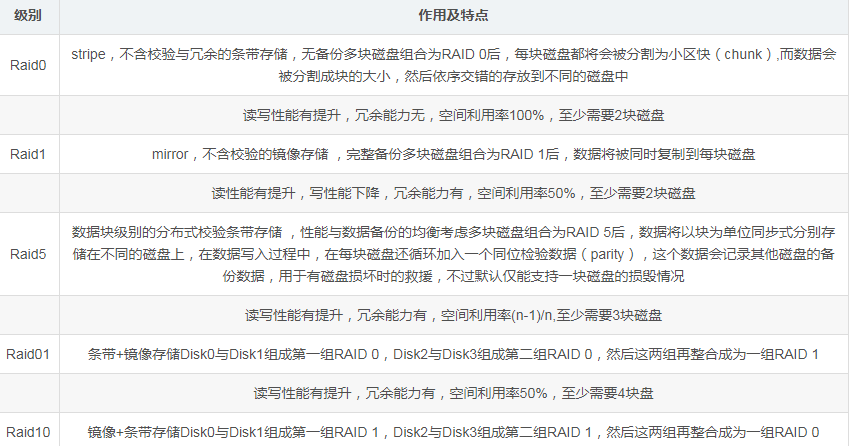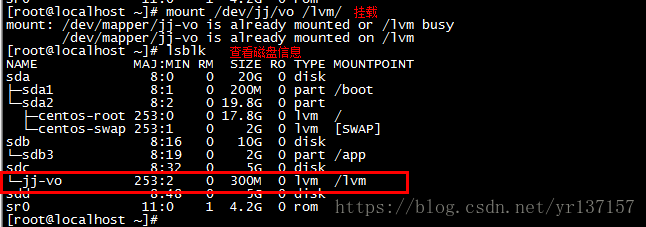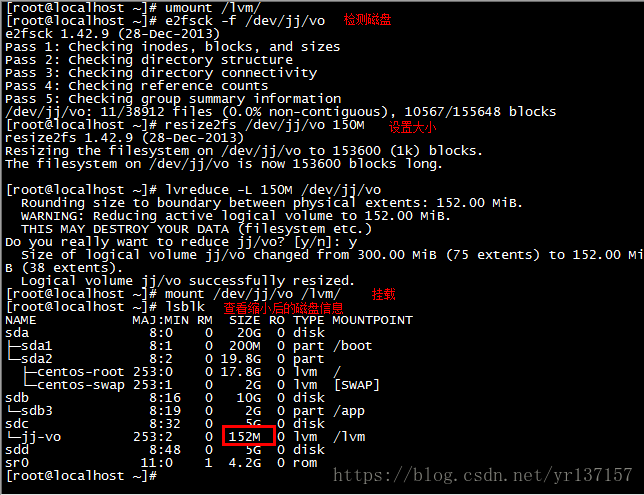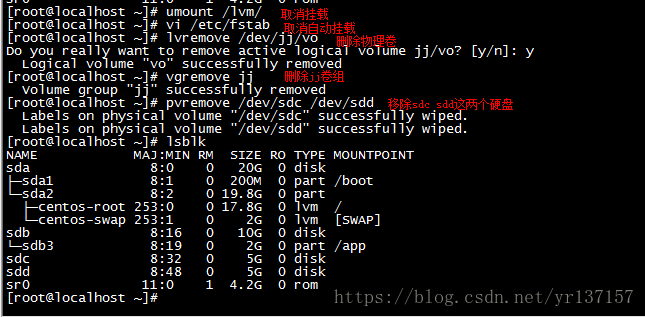, RaidRAID (redundant array of independent)
Concept: RAID technology by combining a plurality of hard disk devices into a larger capacity, better safety disk arrays, and cut into the plurality of data segments are stored in respective different on the physical hard disk device, and then use technology to improve the overall stripe performance of the disk array, and the plurality of copies of important data is synchronized to a different physical disk devices, which play a very good data redundancy backup.
Common raid levels and concept
Two, the management software for the mdadm RAID disk array system Linux
madam linux command is used to create and manage software RAID, a Linux kernel md (multiple devices) RAID device management module at the bottom, it will be in the application layer provide a tool to our application mdadm
Reference: https: //blog.csdn.net/u012701023/article/details/46792165 https://www.cnblogs.com/du-z/p/10876697.html
effect
-a detection device name
-n Specifies the number of devices
- RAID level specified l
-C created
-v display process
-f simulate damage
-r removal device
-Q view summary information
-D detail information
-S stop the RAID
RAID settings at startup and automatically mount
Let RAID boot, RIAD configuration file named mdadm.conf, the default file does not exist, it has to be established. The main effect of the presence of the configuration file is automatically when the system starts to load software RAID, but also facilitate future management.
mdadm.conf file consists of the following components:
DEVICES options to develop the composition of all equipment, ARRAY option to specify RAID array
Device name, RAID level, UUID number array number of active devices and equipment.
Automatic start raid
First create this file /etc/mdadm.conf
mdadm --detail --scan > /etc/mdadm.conf
To do some changes to this file: vi /etc/mdadm.conf
Data plays an important role in today's enterprise, security of data storage but there is one important issue that people use computers to note. People usually use a variety of server-side redundant array of RAID technology to protect data, the high-end servers generally provide expensive hardware RAID controllers, but many SMEs not sufficient funds to withstand this overhead. We have no way to implement RAID by software? In fact, Linux can be implemented by hardware software RAID functionality, thus saving investment, but also to achieve good results.
RAID1 array of start and stop commands. Start direct execution "mdadm -as / dev / md0" can be. Performing mdadm -s / dev / md0 to stop RAID1 array. Further startup command script file is added -as / dev / md0 mdadm disposed in an array will start with the system to activate the rc.sysinit.
Three, Linux LVM management and use
Although the hard disk device management technology can effectively improve the access speed of the hard disk device and the security of data, but in the hard disk is divided into many areas, or after deployment of the RAID think modified partition size of a hard disk is not easy, required in this case the LVM
the LVM (the logical Volume Manager) managed by logical abstraction encapsulates the underlying physical hard disk, shown in the form of a logical volume to the upper system can dynamically adjust the size of the logical volume, without losing the existing data. Newly added hard disk does not change the existing upper logical volume. As a dynamic disk management mechanism, technology has greatly enhanced the flexibility of logical disk management
test:
1, create a logical volume (newly added two hard disks in a virtual machine)




2、扩容逻辑卷为300m


3、缩小逻辑卷

4、删除卷组

https://blog.csdn.net/yr137157/article/details/83347840
https://blog.csdn.net/aaaaaab_/article/details/80159871